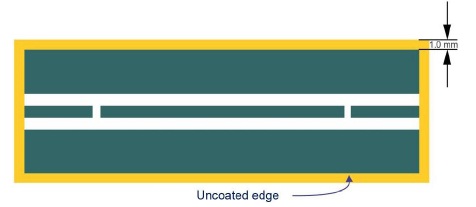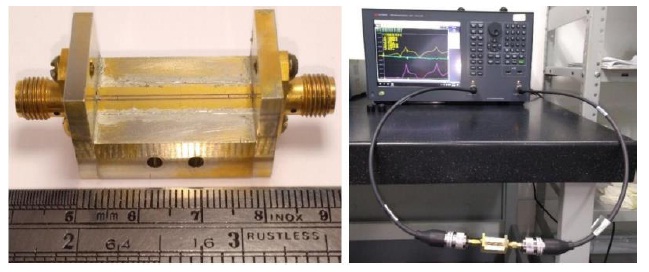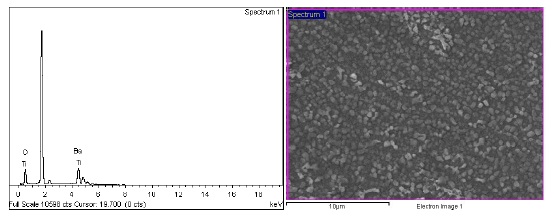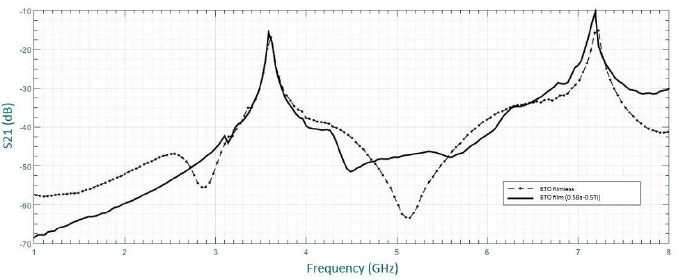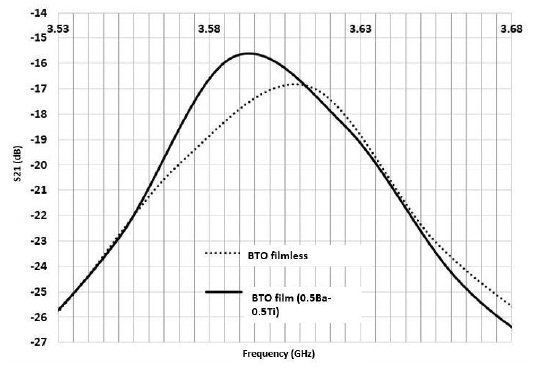I. Introduction
Ferroelectric materials are characterized for presenting a spontaneous polarization in absence of an electric field [1]. This particularity has brought electronic industries to use these materials in the GHz region for the optimization and miniaturization of measurement devices, frequency and telephony analyzers [2]. One of the most common ferroelectric materials applied in microwave frequency tuning is the barium titanate (BTO or BaTiO3 for its chemical formula) [3,4,5,6,7]. Said process can be made by depositing films of the material through Sol-Gel synthesis on resonators elaborated in Coplanar Waveguides (CPW) [8-9].
The So-Gel process consists in the preparation of a colloid stable solution (“Sol”) from de precursors that produce a network of macromolecular oxide, that gels into a film when it dries [10-11]. Authors such as O. Harizanov et al, S. Sharma et al, y D. Tripkovic et al, used the Sol-Gel synthesis to obtain slim BTO films through deposition techniques such as dip coating, spin coating and Inkjet, respectively [10, 12-13]. In this paper the dielectric characterization of BTO is presented, so that it is possible to ensure a high εr under acceptable structural and morphological conditions.
II. Methods
A. Preparation of the BTO via Sol-Gel
The procedure was adapted in a humid way and at room temperature (22 °C) for the Sol-Gel method reported by Balachandran et al [14], using as precursor the titanium isopropoxide (IV) or TTIP (Alfa A13703) and the barium acetate (Merck). In this sense, 0.387 g of barium acetate were mixed with 3.0 ml of deionized water with constant agitation of 320 rpm, until the barium acetate was completely dissolved (solution 1). Then, 3.0 ml of acetic acid were added to 0.468 ml of TTIP until a homogenous mix was obtained (solution 2). Later, both solutions were mixed with a molar proportion Ba/Ti of 0.5/0.5. Then, ethylene glycol was added in a 1.1 relation to acetic acid.
The BTO deposition was made at room temperature (22 °C) over crystalline silicon and CPW resonators, using a spin coater at 2000 rpm during five seconds. The recovered substrates dried at room temperature and were submitted to a thermic treatment with rising temperature of 400 °C (1 °C/min), maintained at 900°C (5 °C/min) during an hour, then cooled down by natural convection during 12 hours until they reached room temperature.
B. Characterization of BTO films
1) Atomic force microscopy. The measurement of the width for the crystalline silicon substrates and CPW resonators with BTO film was made using the intermittent contact mode without previous preparation of the sample. In order to do that, a Nanosurf ® microscope model Easyscan2 AFM was used, occupying a CT170R-25 probe with a conic form 15 µm high, curvature ratio of 8 nm and resonance frequency of 170kHz.
2) Sweep electronic microscopy. The analysis of sweep electronic microscopy (SEM) allowed us to determine the morphology of the BTO without a special preparation of the sample. A Phenom G2 pro® microscope was used with a 7kV voltage.
3) X-ray energy dispersion spectroscopy. The EDS analysis gave information about the elemental composition of the evaluated material, through the use of a thermionic JEOL-JSM 6490LV® microscope with a 16kV voltage. Before making the analysis, the samples were covered with gold through sputtering process.
4) Dielectric characterization. To perform the dielectric characterization CPW resonators as described by Marulanda et al [15] were elaborated. The Figure 1a shows the structural dimensions of the CPW that consist of a central conducting line (s), two ground planes (g), gap (w), a gold metallization thickness (f), an alumina polished substrate that covers all of the height h and with relative permittivity (er = 9.8). Additionally, the parameters a, b and c are shown, which make reference to the geometric parameters of the CPW. With the previous parameters, the design was defined (Figure 1b), to later elaborate the configuration model in CAD and use a LPKF ProtoMats® plotter to fabricate the CPW resonators (Figure 2).
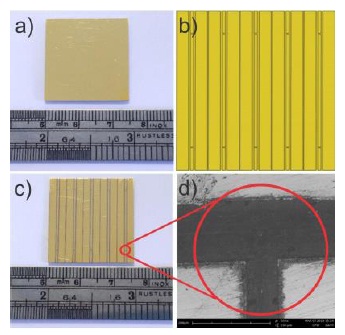
Fig. 2 Elaboration of CPW resonators. A) Superficial view of the dielectric substrate, b) CAD design of the CPW transmission line, c) Plot over the dielectric substrate, d) SEM image of the plot.
1.00 mm of each border of the CPW circuit was isolated with vacuum and high temperature tape (Figure 3), to measure the thickness and correctly make the connections to the vector network analyzer.
5) Frequency Response of the resonator circuits. An Agilent E5063A® VNA of two ports was used with a measuring range between 0.1 and 8.5 GHz, and without previous preparation of the circuits that were joined to a RP SNA type coaxial ensemble (Figure 4). The measuring of the frequency response of the CPW+DUT was made for resonators with and without the BTO film, to avoid the displacement in the measures of the S parameters.
III. Results
A. Structural and Morphological Characterization
In Figure 5a it is shown by the difference in the tonality the presence of the BaTiO3 film with a thickness of 0.77 µm (770 nm); superficial defects or scratches can be seen, generated by the action of the laser during the CPW circuit impression process (Figure 3d). Figure 5b depicts the BaTiO3 film with the presence of separated nanoparticles with spherical shapes and average size of 4.10 ± 0.46 µm (4100 ± 460 nm).
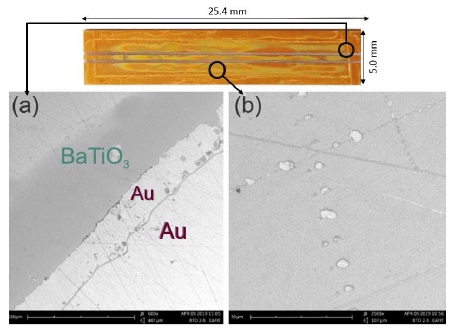
Fig. 5 BaTiO3 film morphology. a) Interface between the gold metallization (right) of the CPW resonator and the BaTiO3 film (left), b) BaTiO3 film deposited on the CPW resonator.
The EDS analysis was made for BTO layers deposited on a crystalline silicon substrate, these layers added a net thickness of 0.55 µm (550 nm). In Figure 6 it can be seen for the BTO layers deposited on a superficial morphology which is granular and composed of individual particles with homogeneous sizes of approximately 0.71 ± 0.37 µm (710 ± 370 nm), which is attributed to the liquid phase synthesis process [7]. The elemental EDS analysis shows an elemental composition in atomic percentage of 14.62 % Ba (L), 79.73 % O (K) y 5.65 % Ti (K).
B. Dielectric Characterization
Figure 7 depicts the peaks of resonance obtained through the comparison of the S21 parameter measurements done with the VNA analyzed for the CPW with and without BTO film. By making a close up to the first peak with resonance frequency of 3.60 GHz, a light displacement to a lower frequency of the CPW resonator with BTO film can be seen. Through simulations made with CST Microwave Studio Suite®, a dielectric relative constant (εr) of 160 was determined for the covering material (BTO) and a Tanδ of 0.012. These results have similarities with those reported by [16], who obtained a dielectric constant of 120 to 10 kHz for thin BTO films deposited by RF magnetron sputtering. Here it can be highlighted that the process of obtaining the particles defines the final dielectric characteristics of the material.
IV. Discussion and conclusions
In the present paper, structural, morphological and dielectric characteristics of BTO films deposited on CPW resonators through the Sol-Gel technique are reported. Thicknesses of BTO film deposited on crystalline silicon substrates and CPW resonators of 0.55 µm (550 nm) an 0.77 µm (770 nm) respectively were obtained. Additionally, a dielectric relative constant (εr) of 160 was determined for the BTO film, as well as a loss tangent (Tanδ) of 0.012 for a resonance frequency of 3.60 GHz, dielectric characteristics that are of particular interest for microwave applications.















